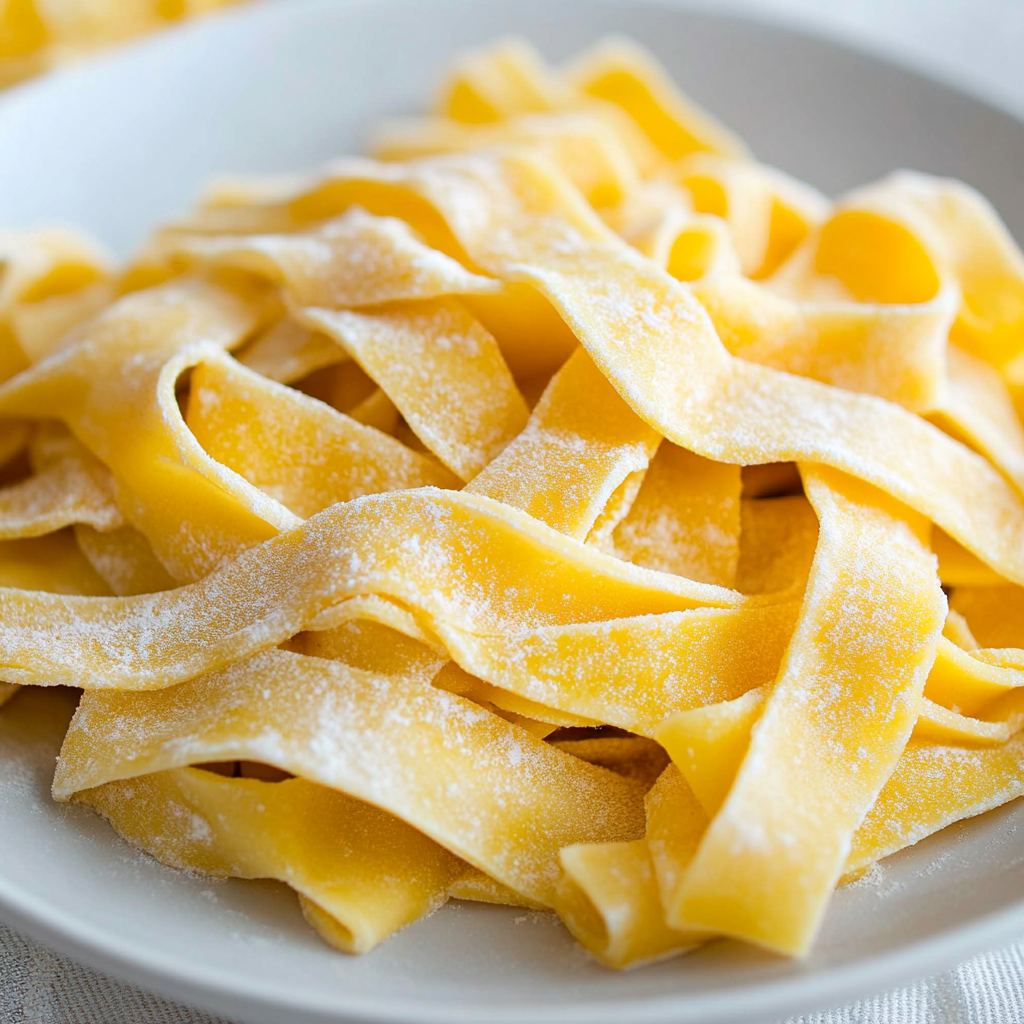What Are Gluten-Free Egg Noodles?
Gluten-free egg noodles are a wonderful substitute for traditional pasta. Made without wheat-based ingredients, they cater to those with gluten sensitivity or celiac disease. These noodles are designed to replicate the hearty texture and rich flavor of their traditional counterparts, offering a satisfying option for gluten-free meals.
- Typically made using flours like rice, tapioca, or almond.
- Suitable for dishes ranging from soups to casseroles.
- An essential choice for anyone following a gluten-free diet.
Their ability to closely resemble regular egg noodles in taste and texture makes them a popular gluten-free alternative.
The History of Gluten-Free Egg Noodles
The creation of gluten-free egg noodles is closely linked to the rise in demand for gluten-free products. As awareness about gluten intolerance increased during the late 20th century, the need for better alternatives grew. Early gluten-free products often lacked quality, but advancements in food technology soon changed this.
Key developments include:
- The surge of gluten-free diets in the 1990s and beyond.
- Innovations in flour blends for improved texture.
- Wider availability in both specialty and mainstream stores.
These milestones have made gluten-free egg noodles a practical and tasty solution for many.
Why Choose Gluten-Free Egg Noodles?
For those avoiding gluten, these noodles offer more than just an alternative—they represent a healthier, inclusive option. Whether for managing gluten intolerance, celiac disease, or exploring a gluten-free lifestyle, they provide several advantages.
Benefits of choosing them:
- Health Benefits: Avoids gluten-related discomfort.
- Dietary Compatibility: Fits into paleo, keto, and other special diets.
- Versatility: Ideal for soups, stir-fries, and more.
Enjoy your favorite dishes without sacrificing flavor or texture, making them an excellent addition to any meal plan.
Key Ingredients in Gluten-Free Egg Noodles
Unlike traditional noodles, gluten-free versions rely on specialized ingredients to mimic the texture and flexibility of wheat-based products.
Typical components include:
- Gluten-Free Flours: Such as rice, potato starch, or tapioca.
- Eggs: For richness and structure.
- Binding Agents: Like xanthan gum to improve elasticity.
These carefully chosen ingredients assure a delicious and gluten-free experience.
How Gluten-Free Egg Noodles Differ from Regular Noodles
Although designed to imitate regular noodles, gluten-free egg noodles have distinct differences:
- Texture: Softer due to alternative flours.
- Cooking Time: Requires precise timing to avoid overcooking.
- Flavor: Often milder with a subtle nuttiness.
Understanding these characteristics insures optimal preparation and enjoyable results.
Health Benefits of Gluten-Free Egg Noodles
Incorporating gluten-free egg noodles into your meals can offer notable health advantages, particularly for those with gluten sensitivities.
Key benefits include:
- Reduced Inflammation: A better choice for individuals sensitive to gluten.
- Improved Digestion: Avoids irritants commonly found in wheat products.
- Nutritional Variety: Many gluten-free flours include added nutrients.
These benefits make them a thoughtful and health-conscious option.
Top Brands Offering Gluten-Free Egg Noodles
Many trusted brands now produce excellent gluten-free egg noodles:
- Tinkyáda: Renowned for its rice-based products.
- Jovial Foods: Artisan-crafted organic options.
- Barilla: A mainstream brand offering gluten-free varieties.
- Examine Cuisine: Innovative blends featuring legumes.
With these options, you can find a product that suits both your taste and dietary requirements.
Homemade Gluten-Free Egg Noodles: A Simple Guide
Creating gluten-free egg noodles at home is both rewarding and straightforward. Here’s a quick recipe:
Ingredients:

- 2 cups gluten-free flour blend
- 3 large eggs
- 1 tsp salt
- 1 tbsp olive oil
Steps:
- Mix flour and salt in a bowl.
- Create a well in the center and add eggs and oil.
- Combine until a dough forms, then knead gently.
- Roll out and cut into thin strips.
- Cook in salted boiling water for 3–5 minutes.
Homemade noodles offer freshness and customization, perfect for any dish.
Cooking Gluten-Free Egg Noodles: Tips for Success
To achieve the best results when cooking them:
- Use Ample Water: Prevents sticking.
- Stir Often: Insures even cooking.
- Watch the Time: Avoid overcooking.
- Rinse Post-Cooking: Maintains texture.
These steps guarantee a delicious, well-cooked meal.
If you’re looking to complement your noodle dishes, consider pairing them with the Best Combination for Garlic Bread. The garlic bread’s crunch contrasts wonderfully with the noodles’ soft texture.
Popular Recipes Featuring Gluten-Free Egg Noodles
Gluten-free egg noodles work beautifully in numerous recipes. Some popular options include:
- Chicken Noodle Soup: A comforting classic.
- Beef Stroganoff: Creamy and satisfying.
- Vegetable Stir-Fry: Quick and healthy.
- Pasta Salad: Great for gatherings.
These dishes showcase the versatility of them, making them a must-have in your kitchen.
Here’s the rephrased article with the keyphrase density adjusted to meet the recommended limits while maintaining readability and SEO value:
Nutritional Comparison: Gluten-Free Egg Noodles vs. Regular Noodles
When evaluating them against regular options, the nutritional differences become apparent. Gluten-free varieties are often crafted with alternative flours like rice, corn, or tapioca, which typically have less protein compared to wheat-based noodles. However, the inclusion of eggs can increase the protein content in these alternatives.
Key Nutritional Highlights:
- Carbohydrates: Traditional noodles made from wheat flour tend to have more carbohydrates. Depending on the base flour, gluten-free options may have a slightly reduced carbohydrate content.
- Protein: The addition of eggs boosts the protein level in gluten-free noodles, making them suitable for high-protein diets.
- Fiber: Gluten-free options can lack fiber compared to whole-wheat versions unless they are enriched with ingredients like psyllium husk or flaxseed.
Recognizing these differences can help you make informed dietary decisions, especially if you’re adopting a gluten-free lifestyle.
Best Sauces and Pairings
Selecting the right sauces increases the flavor of gluten-free egg noodles. Their mild taste and adaptable texture make them ideal for various culinary styles, proving that gluten-free meals can be both delicious and diverse.
Top Pairing Ideas:

- Tomato-Based Sauces: Marinara or arrabbiata complements the noodles well—assure the sauce is gluten-free.
- Creamy Sauces: Options like Alfredo or carbonara add richness and pair nicely with the texture of gluten-free noodles.
- Asian-Inspired Flavors: Tamari or coconut aminos can be used as soy sauce alternatives, combined with sesame oil and ginger, for a savory stir-fry.
- Herb-Infused Oils: A drizzle of olive oil with garlic and parsley offers a simple yet satisfying dish.
Experimenting with different combinations keeps gluten-free meals exciting and full of flavor.
Suitability for Different Diets
Gluten-free egg noodles are an excellent choice for individuals with gluten sensitivity or celiac disease, but they may not suit everyone.
Who Benefits:
- Gluten-Intolerant Individuals: These noodles are a safe alternative for those avoiding gluten.
- Low-Gluten Diet Followers: An excellent option for reducing gluten intake without sacrificing taste.
Potential Drawbacks:
- Caloric Content: Some varieties may contain more calories due to added starches.
- Allergens: Check labels for potential allergens like eggs or certain gluten-free flour.
Understanding these factors insures that gluten-free noodles fit your dietary needs effectively.
Overcoming Common Challenges
Making gluten-free egg noodles at home can be tricky, but addressing common pitfalls insures better results.
Challenges & Solutions:
- Crumbly Dough: Gluten-free flours lack elasticity. Add xanthan gum or psyllium husk to improve structure.
- Cooking Issues: Overcooking can lead to mushy noodles. Monitor closely to retain firmness.
- Binding Problems: Allow the dough to rest, allowing moisture to absorb fully for easier handling.
With these tips, your homemade gluten-free noodles can rival store-bought options.
Storage Tips
Proper storage extends the freshness and quality of gluten-free egg noodles, whether they’re fresh or cooked.
How to Store:
- Fresh Noodles: Keep in an airtight container in the refrigerator for up to three days.
- Cooked Noodles: Refrigerate in a sealed container with a bit of oil to prevent sticking, and use within five days.
- Freezing: Lay noodles flat to freeze individually, then transfer to a freezer bag for up to three months.
By following these methods, you’ll always have noodles ready for your next meal.
Choosing High-Quality Options
Not all gluten-free noodles are the same. Prioritize quality to boost your dining experience.
What to Look For:
- Ingredients: Opt for simple, recognizable ingredients without artificial additives.
- Texture: High-quality noodles remain firm after cooking and don’t become gummy.
- Brand Reputation: Choose trusted brands with positive feedback from gluten-free communities.
Careful selection insures the best results in your dishes.
These noodles are an excellent base for creative recipes, such as those found in the Best Crack Chicken Noodle Soup Recipe, which pairs beautifully with their smooth texture.
For Kids
These noodles are a hit with families, offering a mild flavor and soft texture that kids enjoy.
Why Kids Love Them:
- Versatility: Perfect with kid-friendly sauces like cheese or mild tomato.
- Nutritional Value: Eggs provide essential protein for growing children.
- Gentle on Digestion: Gluten-free varieties are easy on sensitive stomachs.
Creative recipes can turn these noodles into a family favorite.
For an innovative take, consider the Turmeric Chicken Noodle Soup. This recipe integrates the health benefits of turmeric with the comforting essence of chicken noodle soup, offering a burst of flavor in every bite.
Environmental Considerations
The production of gluten-free noodles has both benefits and drawbacks. Understanding these helps consumers make eco-conscious decisions.
Positive Impacts:
- Diverse Agriculture: Using non-wheat flour promotes crop variety.
- Local Support: Many gluten-free ingredients are sourced from small-scale farms.
Negative Impacts:
- Resource Use: Some flours, like rice, require significant water resources.
- Packaging Waste: Single-use packaging is common in this market.
Balancing these factors supports more sustainable consumption habits.
FAQs
- Are all gluten-free egg noodles dairy-free? Not always. Check labels for hidden dairy ingredients.
- Can they replace regular noodles in recipes? Yes, but adjust cooking times as they may cook faster.
- Do they taste different? The texture and flavor are slightly unique but pair well with a variety of sauces.
In conclusion, Gluten-free egg noodles offer a delicious and versatile alternative to traditional pasta. With thoughtful preparation, quality selection, and creative pairings, these noodles can cater to various dietary needs while maintaining excellent taste. By considering sustainability and addressing common challenges, you can enjoy them as a valuable addition to your kitchen repertoire.

